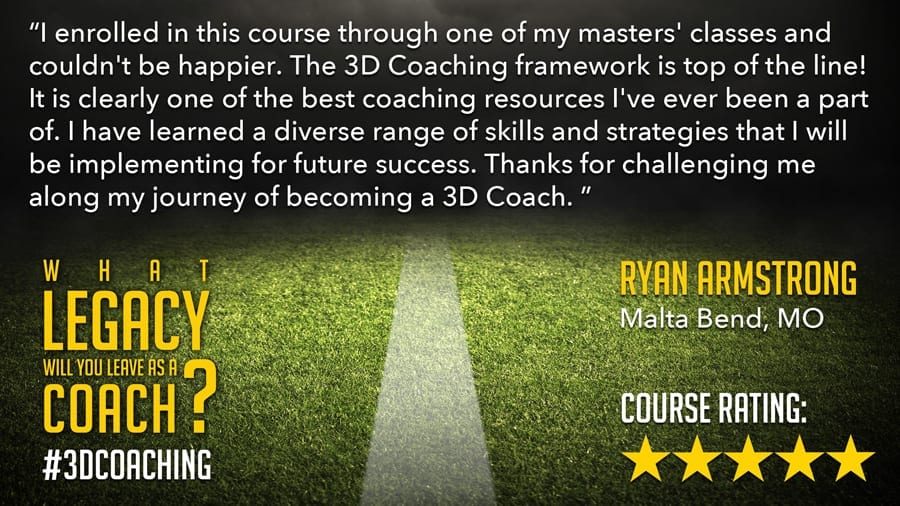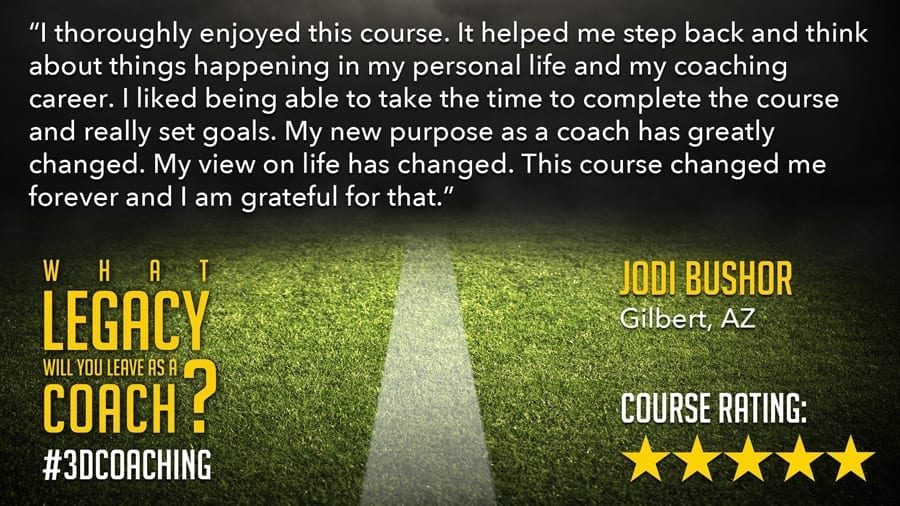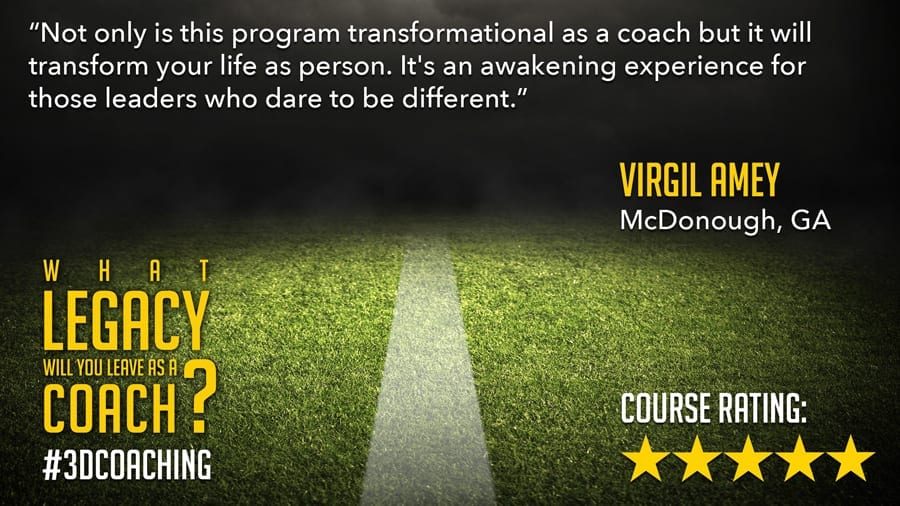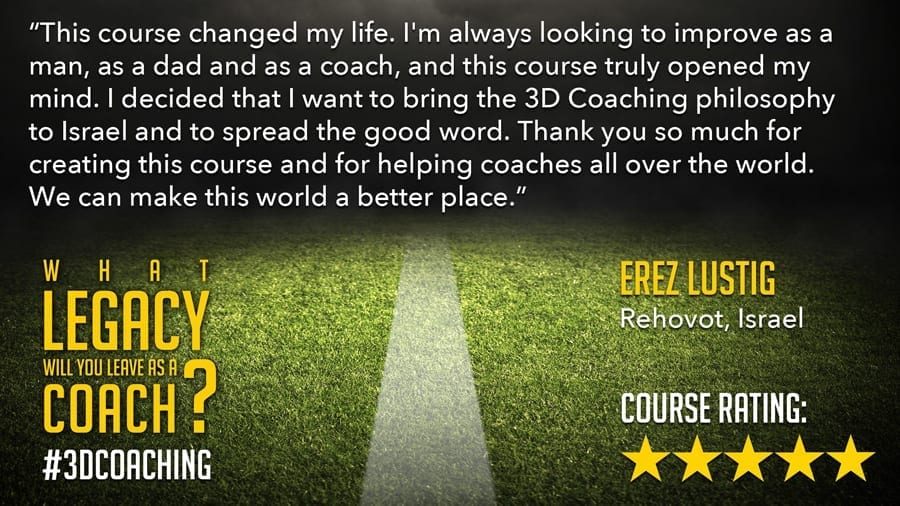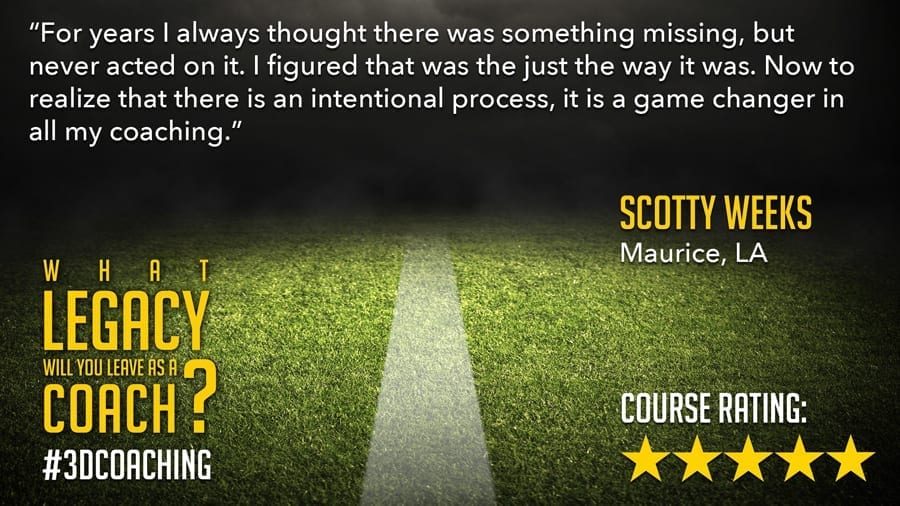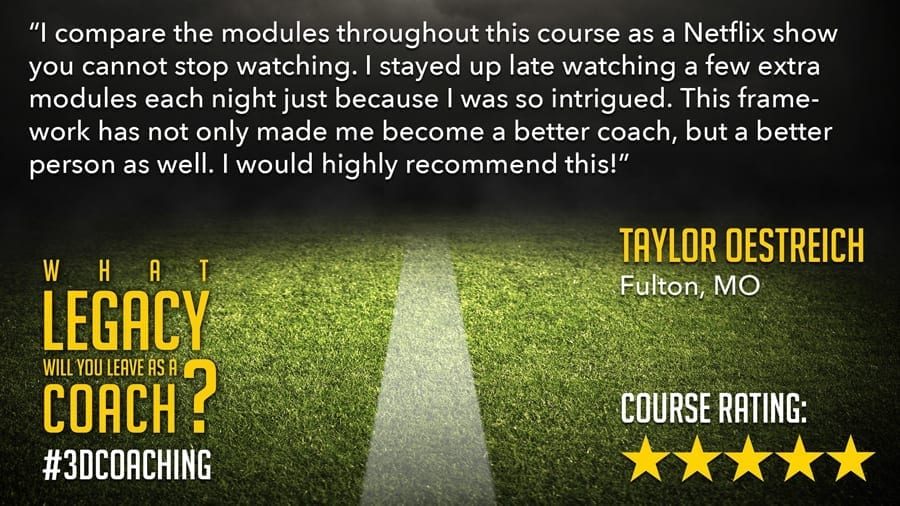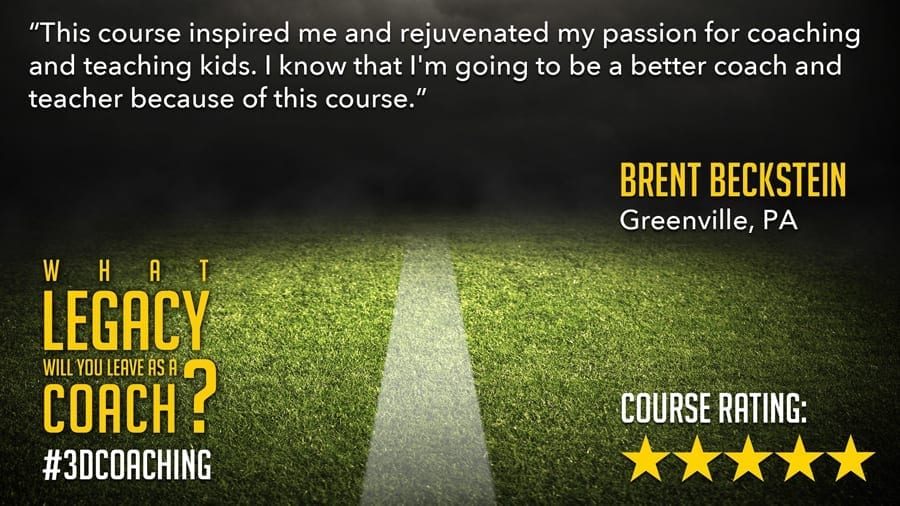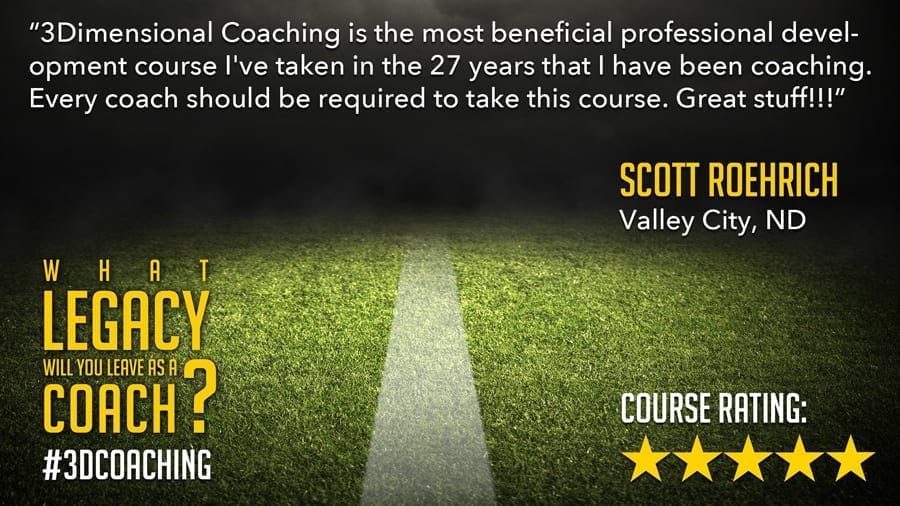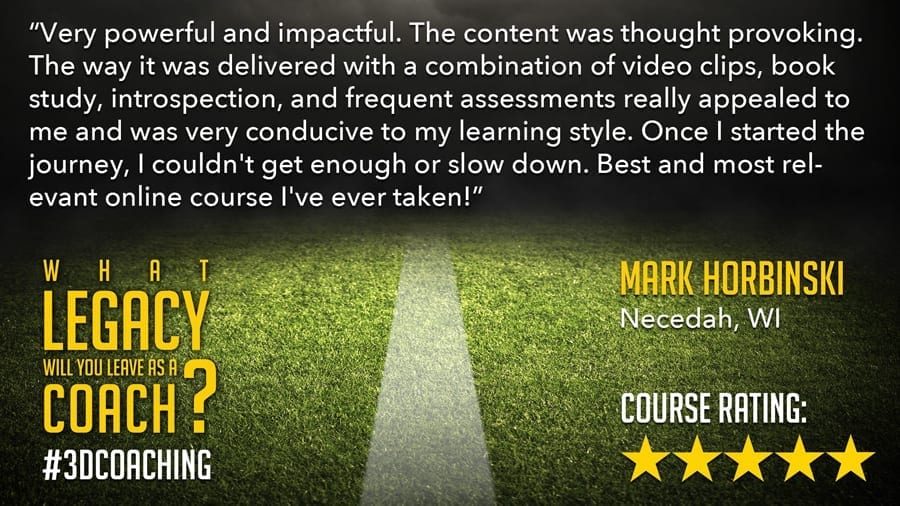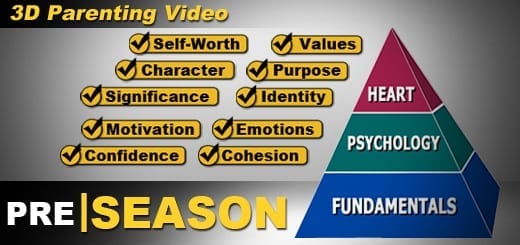Coach Stone Podcast Featuring Wes Simmons
 Wes Simmons
Wes Simmons
Podcast: 90% Mental Podcast Featuring Wes Simmons
90% Mental Podcast Featuring Wes Simmons
The 3D Coaching Success Factor
The 3D Coaching Success Factor
Build a Winning Culture by Determining Your Success Factor.
Kevin Davis
Throughout my coaching career, I have implemented many dynamics that I learned during my high school and college playing careers. Some of the methods were effective, but, early in my career, I noticed that some of them were not effective. This clarity came when I decided to study and internalize the practical methods of the 3-Dimensional Coaching Framework, which consists of three foundational principles: Physical, Mental, and Heart. As I meditated on the concepts and looked back on my playing career, I recognized that I lacked in each area. Further, the 3D Framework helped me realize that my coaching methods lacked focus in two essential areas: (1) Mental and (2) Heart. Once I understood those shortcomings, I was able to focus my current coaching style and methods to be inclusive of all three dimensions. This knowledge has assisted my effort of completely developing those athletes for which I have been given the responsibility to grow. Since being introduced to the 3D Coaching Framework, my view of Success and Winning has evolved.
By profession I am an accountant, so when I was learning about 3Dimensional Coaching, my mind instantly wondered about how to define success. Essentially, how can success be quantified within this framework? Initially, I believed that success could not be quantified – while coaches may notice growth in athletes, there was not a formulaic way to quantify whether the methods were effective. Contrarily, I now believe that I was incorrect. While quantifying success may be challenging, it is possible to quantify your ability to be successful. The first thing you must do is define success correctly. Many coaches, including me, determine success by winning games; however, under the 3D Framework, I learned that winning games is a by-product of implementing the three foundational principles (physical, mental, and heart). From my standpoint, success first starts by winning your athletes’ hearts! While it may be difficult for some coaches to accept this concept, as we have been conditioned to focus on the physical training and winning games, if you would allow yourself to consider this approach you will soon learn that if you win your athletes’ hearts, the wins will follow.
With the above in mind and desire to quantify success, I came up with what I call the 3D Coaching Success Factor. The 3D Success Factor states that the percentage of time spent on each level of the 3Dimensional Framework will determine the percentage of your ability to be successful.

This equation can also be based on the number of hours allocated to each level of the framework.
*The numbers below are based on a football season but can be adjusted for time spent in other sports. A typical football season is 13-17 weeks, depending on whether or not you make the playoff; so, an average 15 weeks.
- 15 weeks x 5 practice days per week = 75 days with your athletes.
- 75 days x 3 hours/day = 225 hours with your athletes.
- Then doubled to include the off season hence the 450 hours

The biggest thing about the success factor equation is that no level of the 3D framework can equal zero. There must be time spent in each area of the 3D Framework in order to get the best out of your athletes. So, in the equation below, I propose that “In Season” (represented by P1, M1, H1), a coach’s hours committed to the “Physical” component cannot be less than 100 hours and no more than 175 hours, which is understandable due to preparation for games. The time spent on the “Mental” and “Heart/Spiritual” areas should be no less than 25 hours and no more than 100 hours for either. These hours are then divided by the total in season hours.
During the off season (represented by P2, M2, H2, the same concept exists except there is a change in the minimum hours (50 hours) and the maximum hours (125 hours) for each of the three components.
Add the total together and then divide by 2 to get the success factor.

Physical – Committing 175 hours in season, 100 in the off season
Mental – Committing 25 hours in season, 75 in the off season
Heart – Committing 25 hours in season, 50 in the off season
Success Factor = 100%
Example 2 (Percentage of Time Spent)

Physical – Committing 80% of time in season, 30% in the off season
Mental – Committing 10% of time in season, 10% in the off season
Heart – Committing 10% of time in season, 25% in the off season
Success Factor = 100%
These numbers will adjust based on the coach’s preference and where the emphasis is placed; no two success factors are required to be the same. However, as you input the hours or percentages, you will be able to determine if your structure is leading to a success factor that will aid in the growth of your athletes. Your aim is 100%. If there is less than 100%, you may want to consider making some changes in order to get the best out of your athletes.
Once again, the biggest thing is that YOU HAVE TO DEFINE WHAT IT MEANS TO BE SUCCESSFUL. The culture you establish must have the factors of success, within the 3D Framework, woven throughout it. Once that occurs, you will begin to win your athletes’ hearts and, in time, win their commitment, then win practice, followed by winning the day, and eventually you will win games! Remember, the Heart is most critical, and that is what we are after!
Raising Your Level
Raising Your Level
By Wes Simmons
When a discretionary activity like sports becomes too boring or too frustrating for too long, kids quit. However, when coaches develop strategies to engage athletes in the 2nd and 3ra Dimensións, sports become a life-giving experience for everyone involved. When this happens, the joy of the activity can override any entitlement mentalities that exist and provide the intrinsic Motivación for kids to stay on the journey. We want to help.
When the level of joy in a program increases, the athletes’ collective attitude and effort will elevate with it.
Motivation: The Essence of Coaching
Motivación: The Essence of Coaching
By Wes Simmons
In many ways, Motivación is the essence of coaching. A coach’s job is to help athletes pursue and persist toward the pursuit of both short-term and long-term goals. Late Dallas Cowboys football coach Tom Landry summed this part of the job up very well when he said, “A coach is somebody who gets people to do what they DON’T want to do in order to obtain that which they DO want to obtain.”
When a coach helps an athlete overcome the constant temptation to choose immediate gratification, and instead opt for staying committed to the long-term process, it is a very rewarding experience. But…
As Dr. Duke shared in the video, we live in an age of extrinsic Motivación. Extrinsic Motivación occurs when the inclination to pursue and persist is encouraged with either positive external factors such as scholarships or trophies, or negative external factors like the threat of punishment or coercion. Intrinsic Motivación occurs when that inclination is driven by an interest
in or enjoyment of the task itself, and exists within the individual rather than relying on external pressure.
External Motivación is not necessarily “bad” or “wrong.” In reality, there are plenty of instances where extrinsic Motivación is actually “good” and “right!” However, always remember that extrinsic Motivación produces a diminishing return. In other words, in order for it to continue working at it’s current success rate, it will always require more and more. At the same time, it tends to deliver less and less. As the expenditures go up, the effectiveness goes down.
There’s a better way. Check out our online course for certification and/or college credit if you would like to receive more training on HOW to motivate intrinsically. For now though, I’ll give you the cliff-notes version. To help athletes regain a sense of intrinsic Motivación, create strategies to step into the lives of your athletes away from the normal athletic environment. This simple act will help move the Motivación away from the “stuff,” and toward a stronger relationship between you and your athletes. When the Motivación springs forth from a well of healthy relationships, athletes will pursue and persist at a whole new level. As an authority figure in their lives who shows that you care, they won’t want to let you down.
P.S. – I would also highly recommend the book Drive by Dr. Daniel Pink to learn “the surprising truth about what motivates us.”
The Magic Bullet for Happiness
The Magic Bullet for Happiness
By Mark Hull
Recently I watched an interview of Barbara Bradley Hagerty on PBS’s Newshour where she was discussing her book Reimagined: The Science, Art, and Opportunity of Midlife.
Here’s part of the interview:
“The Happiness Research Center in Copenhagen looked at job satisfaction and what they found is that the key thing to job satisfaction, the most important thing, is having a Propósito, feeling like your job has a Propósito. It could be that you feel either personally that your job has a Propósito or that you’re part of an organization with a greater mission. Propósito turns out to be the magic bullet for happiness across the board. Not just at work but having a Propósito in life tends to make you healthier, it means that you stave off dementia better than other people, it means that you are much less likely to have a stroke or be sick, it is a wonderful quality to have. The idea that you have a Propósito for life, a reason to get out of bed in the morning.”
The clearer we can state our Propósito, the more accurately we can pursue it, and the more powerful its effect. But remember, a clear understanding of Propósito only comes through a journey of discovery. Coaches must seek to understand how cultural influences and pressures, along with their own individual experiences, have shaped their understanding of why they coach.
Let us help you discover and build on the solid ground of a transformational Propósito, not the sinking sand of a transactional coaching philosophy.
Be The Best You Can Be
Be The Best You Can Be
By Wes Simmons
As the clock ticked down to zero in the final moments of my college athletic career, the reality and finality of it all began to set in. It almost felt like a death of sorts. In many ways, it was. From the time I was 4-years-old, I identified as an ATHLETE. All of a sudden as a 22-year-old man, IT… WAS… OVER. As I sat in the locker room with a trail of tears burrowing through the dirt left on my face from the game, I began to mourn the “death” of an athletic career. Maybe more forthcoming, it marked the end of my performance-based Identidad as an athlete.
“What now?” I remember thinking. The only logical next step to me at that time was to begin coaching. I was fortunate to have the opportunity to begin my coaching journey as a Graduate Assistant at my Alma Mater. Though it didn’t quite fill the void of no longer playing, I was excited and thankful to join the staff that had made such a tremendous impact on my life.
But, I have to be honest. My Motivación starting out was not to impact others like my coaches impacted me. I didn’t get into coaching because I “loved kids.” I didn’t have a vision to use my platform to “impact lives.” I got into coaching because I loved the game. More than that, I loved the idea of keeping my Identidad based in the sport I loved. Looking back I now realize that because relationships did not factor into my Propósito as a coach, I coached ONLY in the 1st Dimension.
Coaches, we need to be great in the 1st Dimension. Don’t hear me wrong. We need to be great at coaching the fundamentals of our game if we want to be great coaches. Period. There is no substitute for working hard, instilling proper technique, drilling the fundamentals, and demanding technical/tactical excellence from our athletes. However, if that’s ALL we focus on, we will most likely miss the opportunity to be agents of transformation in their lives. At the 3D Institute, we desire that you become a transformational coach by learning to coach in all 3Dimensions.
For transactional coaches it’s all about performance. Transformational coaches embrace the opportunity to make a difference in the lives of their athletes. They honor and recognize that these athletes are their parents’ most dearly beloved and prized possessions. They understand that they (and their peers) are the future husbands and wives to our daughters and sons. They are cognizant that these young people are the next generation of leaders and mentors. They realize that the athletes who come into their programs are not merely players to be used toward their own end. Rather, they are people entrusted to their care.
To care well for an athlete, we must coach in all 3Dimensions. We all know that there is more to an athlete than just the physical. Under that helmet, there is a mind replete with thoughts and Emociones. Behind that jersey is heart full of hopes and fears. We ARE 3Dimensional beings, and all 3Dimensions are so intricately interwoven that one will affect the other two. If coaches will be just as deliberate about coaching the 2nd and 3ra Dimensións as they are the 1st Dimension, not only will the athlete perform better, but life transformation will occur and we can help athletes be the best they can be… on AND off the field.
Questions to Ask
Questions to Ask
By Wes Simmons
According to Dr. Jeff Duke’s research, and according to our experience, most coaches only coach in the 1st Dimension. In other words, when it comes to the things that coaches are very intentional about coaching during practice time, for most they always fit into one of these 8 categories: Strength, Power, Cardiovascular, Speed, Quickness, Technique, Repetition, or Tactics.
Because sport is primarily physical in nature, coaches better be great at coaching the 1st Dimension if they want to make an impact. Athletes are first and foremost coming out for your program to get better at the sport! However, we all know there is more to a great athlete than just great physical ability. We all know there is more to a great team than just a collection of physically skilled athletes. Underneath every helmet is a brain that represents the mind of the athlete. Behind every jersey is the heart of the athlete, which represents their value system.
We all want athletes who “play with heart,” right? In the 21st century, a key to great leadership is a strategy to capture hearts. So, what is your STRATEGY?
Check out this short video where Dr. Duke poses some key questions that every coach needs to ask if they want to maximize player performance and potential.
Our various 3D resources are designed to help you develop strategies to coach the 2nd and 3ra Dimensións just like you have strategies to coach the 1st Dimension.
The “IT” Factor
The “IT” Factor
By Wes Simmons
I was fortunate to play for some great coaches over the span of my athletic career. My high school coach took over a program that had been mediocre at best for the previous two decades. Within six short years, he turned us into state champions. Two years later, he did it again. Similarly, my college coach inherited a program that didn’t have back-to-back winning seasons in over twenty years before he took over the program. After an initial 0-11 campaign, just four years later he went 15-0 on his way to securing the school’s first of six national championships. It was about so much more than just winning and losing though. You could say that these coaches had the “it” factor.
What do I mean by “it”? At the time, I didn’t have the language to describe “it” very succinctly. All I knew was that we had great relationships and a great unity of Propósito. I knew that we worked really hard, and the Motivación to do so was driven by our commitment to each other. We used words like family and brotherhood. Still, “it” was hard to put into words.
The first time I ever heard Dr. Jeff Duke share the 3D Coaching framework, it was an “Aha!” moment. Hearing about the 3Dimensions of coaching gave me a vocabulary to describe my experience of playing for some of these great coaches. I remember thinking, “That’s IT!” Though they would not have described themselves as such, they were 3D Coaches.
Since that time, I’ve been passionately sharing this simple framework with coaches so they can make the same kind of impact on their athletes that my coaches made on me, both on and off the field. The 3D language has empowered me to share.
A Common Language
One of the greatest long-term benefits of training your coaches in 3D is that it creates a common language that crosses any barriers that may exist between different sports. Language is important because language profoundly shapes culture. As human beings, it’s difficult to think beyond our own vocabulary. Our thoughts are hemmed in by the boundaries of our vocabulary.
Language is critical because all external behavior is derived from internal thoughts. If you want to cultivate a transformational culture in your athletic organization, an important first step is to establish a common language and then reinforce the language in daily conversations.
As leaders seeking to create a culture, it is our job to provide opportunities for the people we lead to grow. At the 3D Institute, we want to help. Check out our various 3D Coaching courses and resources that are designed to help coaches understand the 3D framework and give them the vocabulary to unlock new levels of creativity. We know this: as coaches take the 3D journey, the “Aha!” moment is created and the “it” factor becomes available to all who are willing to rethink their roles and reform their programs.
Get started on the 3D journey today by enrolling in our Course for Certification and/or College Credit!
Seeing With New Eyes
Seeing With New Eyes
By Cal Barr and Wes Simmons
We recently heard from a high school Cross Country coach who has embraced 3Dimensional Coaching. He has completed the online course and now focuses on coaching all three dimensions: body, mind, and spirit. He also now has clearly developed strategies to capture the hearts of his athletes.
I see my student-athletes with new eyes. I now see them more as whole people. The 3D Coaching framework has helped me be more effective in developing Carácter and creating a better environment for learning and performance. I am teaching in a more caring, loving way.
A big part of his focus is now on helping his athletes to cultivate a Growth Mindset. This helps them value effort, embrace challenges, and see mistakes as opportunities to grow. The result of this has been an environment of hope and faith that is filled with the Emociones of love, joy, and peace.
The response has been positive. Athletes enjoy this approach and seem to flourish. Parents take notice as well. One parent talked about the positive growth in his son.
I have seen changes in my son. I am very grateful.
Notice the progression: Before the parent saw the changes in his son, the coach began to see the athletes more holistically. That’s the power of the 3D Coaching framework. The 3D Coaching framework helps coaches see their athletes with new eyes in a new way.
Watch this short video to learn more about the 3D Coaching framework and how it will empower coaches to see their role in a new way. When coaches develop these “new eyes” that this coach described, the impact will be seen throughout the entire community.
Diminishing Problems by Investing in the Right Solutions
Diminishing Problems by Investing in the Right Solutions
By Wes Simmons
Frustrated coaches. Angry parents. Worn out administrators. Burned out athletes. Unhappy fans. Disengaged alumni.
When things go amiss in an athletic program, the impact is felt on many different levels. As a leader in the sports world, we need you to be PROACTIVE instead of reactive when it comes to keeping sports on the right track in your community.
We regularly receive messages about the impact that our 3D Coaching training makes on athletic communities from coaches who take the proactive approach. Recently, we heard from a wrestling coach in Wisconsin who has been implementing his 3D training for the past two years after completing our online training. Here are some quotes from a few different people that are associated with his program:
Players
We know that coach cares about us and wants us to be better prepared for life.
The coaches are invested in my improvement as a wrestler and success as a person.
Parents
I have been to a lot of awards banquets and have never heard a coach talk about my son growing in emotional control. Thank you.
Thank you for caring about my son and helping him grow as a man.
Coach
I experience more joy and peace because I know I am doing all I can to help each wrestler become a better athlete and a better person for life. The 3D approach reduces pressure and increases enjoyment of competition because we focus on the process of growth.
Athletic Director
The wrestling program had more participants, fewer academic problems, no code violations, no parent problems, many positive comments from parents and community and quality performance. This is a great result. I want all our programs to utilize 3D.
Through our online training, this coach has crafted his transformational Propósito statement as: “To coach and mentor student-athletes to persevere life’s trials with a loving heart, kindness, and joyful attitude as they make a difference in others.” He has defined his transformational Propósito and has developed intentional 3D strategies to fulfill it. In other words, because he has invested in his own leadership capacity, his impact is being felt by all who are connected to the program.
How about you? Are you Investing in the Culture You Want to Create? If you invest in the right solutions, you will greatly diminish your problems!
Reigniting the Fire
Reigniting the Fire
By Wes Simmons
There is a relatively new phenomenon sweeping across the sports landscape in America. It’s called, “12-year-old burnout.” According to a recent poll by the National Alliance for Youth Sports, 70% of kids in the U.S. quit playing sports before the age of 13 because, according to the kids, “It’s no longer fun.” This is the unintended consequence of taking an adult model of hyper-competitive athletics, one that WE don’t handle very well at times, and imposing it on our kids at younger and younger ages. The joy is being lost in the journey, and the kids are burning out.
Young athletes aren’t the only ones who are throwing in the towel though. It’s becoming increasingly difficult for athletic directors to retain quality coaches over the long-haul. Here is a short video clip where I discuss, albeit in part, why this seems to be the case and what we can do to empower coaches to persevere through the pressures that come with coaching today.
There has never been a more difficult time to coach than right now. There has never been a more rewarding time to coach than right now either! However, we must first help coaches define WHY they coach.
Recently, we came across the story of a softball coach in Virginia who was teetering on the brink of burnout. Here is his story:
A few years back, after some humbling experiences, I had to finally admit to myself that I was not the best option to inspire and lead young athletes. After all, we were hovering right around .500 and we couldn’t close out close games. Heck, we hadn’t even made it into a final in a tournament yet. We were losing too much, and it was my fault. The more I talked about how I hated losing, and the more I conveyed that to our athletes, the more it seemed to happen. So, I devised my exit plan.
Little did I know, after becoming exposed to the 3D Coaching training, 3D became a monkey wrench in my exit plan. By going through the 3D Coach book, and then the 3D Coaching Course for Certification, I began to realize that there was a different way, a BETTER way to coach these young athletes. Though winning and losing will still be measured on the scoreboard, I began to see that there are much more important wins and losses that are not measured in points.
We started passing these lessons on to our young athletes with a focus on Carácter development and team building. We stopped focusing on the winning and losing and we started to focus on the more important things like: building relationships, loving the sport, loving our teammates, and honoring/appreciating our God-given talents and abilities. We also started emphasizing the need to give back through community service.
The next thing we knew, as if out of the clear blue sky, something very strange happened. We started winning both on AND off the field! However, to win OFF the field it requires us to focus on the fundamentals in all 3Dimensions; Body, Mind and Spirit.
While coaching will always be a roller coaster, I’m no longer focused on my exit plan. Rather, now I focus on how I can improve every day to help young athletes achieve their goals.
This coach rekindled his fire by discovering his WHY behind the X’s and O’s. In the planning phase of the 3D Coaching Course for Certification course, he defined his transformational Propósito as:
To inspire athletes to love their sport, honor each other’s efforts, and have a commitment to excellence that extends well beyond the field of play.
Now, he has a filter for every interaction and activity that takes place within his program. He also has strategies in all 3Dimensions to help him fulfill his stated Propósito. This has produced a change in culture, and the results are taking care of themselves as a byproduct.
If we want to reignite the passion of coaches to coach and athletes to play, the most logical place to start is to help the coaches to define their why. When we know WHY we do what we do, our “how” and our “what” has more impact.
A Common Language
A Common Language
By Wes Simmons
X. Y. Z. Motion. Shotgun. Pistol. Center. Rover. Mike. Sam. Wheel. Dig. Slant. H. 3 Tech. Fire. Flat. Cover 4.
Unless you know football, the string of words above most likely seems random and confusing. It’s hard make any association between them at all unless you’ve studied the game, coached the game, or been a player on the gridiron. Gridiron. There’s another one! The reality is that each sport has a unique language that is spoken and understood by those who are associated with it.
As every coach knows, terminology matters. Regardless of the sport, athletes need to understand the language of the game before they can effectively execute the skills and strategies of the game. For a team to achieve at its highest level, everyone needs to be on the same page and using the same vocabulary. A common language will help align the sails.
One of the greatest long-term benefits that occurs when an athletic department goes through our 3D training is that it creates a common language that crosses any barriers that may exist between different sports. Language is important because language profoundly shapes culture. If you want to cultivate a transformational culture on your team or in your athletic organization, an important first step is to establish a common language with the staff. Once the common language is established, you can seek to reinforce the language in daily conversations.
Remember, as human beings, it’s difficult to think beyond our own vocabulary. Our thoughts are often hemmed in by the boundaries of our vocabulary. This is an important point because all external behavior is derived from internal thoughts. To change a culture, it starts with how the leaders think. Our 3D Coaching training creates a common language that in turn unleashes new levels of creativity.
Leading for Change
Leading for Change
By Wes Simmons
I can still hear his words like it was yesterday. On an ever-so-regular basis, my college coach Mel Tjeerdsma would stand before our team and challenge us with these thoughts:
“Don’t buy the lie that you are staying the same. You are either going this way (with a finger pointed to the sky), or this way (with a finger pointed toward the ground).”
The message was loud and clear. We are either getting better, or we are getting worse. If we aren’t pushing ourselves to grow, we will succumb the natural consequences of atrophy.
Complacency. Satisfaction. To most coaches, these 4-syllable words might as well be 4-letter words! That’s because coaches are leaders, and leaders very quickly become frustrated with an attitude of contentment. Very few things have the capacity to stunt our growth like an attitude of contentment does.
When complacency begins to take us in the wrong direction, how do we as leaders change the trajectory? We must create discontent. Where there is no discontent, there is no change. But remember, discontent by itself is not enough to produce the change we want. We also must have a clear and compelling vision for the future and practical next steps that begin moving us toward that future.
In our 3D Coaching Course for Certification and/or Course for Credit, we have devoted the following unit in Module 21 towards helping coaches understand the “Formula for Change” so they can effectively lead for change in their programs.
Remember, all growth requires change and all change requires a growth mindset. Change is uncomfortable. Therefore, all meaningful change is a process. But, also remember this… all meaningful change is worth it!
Helicopters
Helicopters
By Wes Simmons
Have you ever wondered why today’s adolescent seems to be more anxious, more depressed, and less resilient than those of previous generations? As this article suggests, it likely has a lot to do with how we as adults structure our kids’ lives.
In his 1969 book Parents & Teenagers, Dr. Haim Ginott first coined the now famous phrase “helicopter parent.” Helicopter parents are those who try to hover over every interaction and activity that their children are engaged in. Research continues to make a compelling case that the helicopter approach to governing our kids’ lives, doesn’t seem to be working out so well for the kids!
I certainly don’t want to imply that any well-meaning parent intends to do harm to their child. In most cases, their drive is quite the opposite! However, I do want to continue shedding light on the unintended consequences that come from micro-managing every aspect of our kids’ lives. Most notably, the opportunities for free-play that should abound in a flourishing childhood are being ousted by a rigid calendar full of activities that are designed to prepare our kids for the “next level.”
As you drive around your community, do you see many kids out exploring the neighborhood on their bikes? Where are the backyard whiffle-ball games? Where are the driveway basketball games? The playgrounds are empty and the driveways are vacant. The pressure on parents to make “champions” out of our children is at an all-time high. Consequently, so are anxiety levels along with a myriad of other mental health disorders.
“It is hard to find groups of children outdoors at all, and, if you do find them, they are likely to be wearing uniforms and following the directions of coaches while their parents dutifully watch and cheer.” – Dr. Peter Gray (Read More)
As the people of sport, we need to remember that sport has evolved out of the human instinct to PLAY. Play is life-giving, so sport should be life-giving… right? Does your involvement in sports enhance your relationships and energize you toward a transcendent cause? Or does it drain you and your athletes down in an unhealthy way?
If it’s the latter, we want to help. There is a more excellent way. Our various 3D courses and resources are designed to help coaches establish a team culture that’s rooted in play and life-giving to all.
Understanding is the Basis of Care
Understanding is the Basis of Care
By Wes Simmons
I’ll never forget my inaugural coaching stint as a youth softball coach. I had the privilege of coaching my daughter’s 6U tee ball team and I was excited to get the season started. As the first pre-season practice began, it quickly became evident to me that my 1st Dimension coaching abilities would be put to the test.
I thought we would start practice with some very simple drills to see where the girls were at fundamentally. The first drill was very basic. I told the girls, “I’m going to roll you a ground ball. Your job is to stop the ball with your glove and then throw the ball back to me. Got it?” The girls nodded in affirmation that they understood the drill.
Our first challenge was to make sure that all of the girls had their gloves on the proper hands. Out of twelve girls on the team, I only had to switch around a couple of them. I took this as an encouraging sign! The first girl in line stepped up confidently, bent her knees, and got into a ready position. As I rolled the ball, she moved her feet to get in front of the ball and stopped the slow roller with good form (relatively speaking).
I thought to myself, “So far, so good!”
As it turned out, my instructions were not specific enough. She then proceeded to leave the ball in the glove on her left hand (she was right-handed) and throw it back to me using the glove like a lacrosse stick. Off came the glove with the ball wedged in the pocket. Together, the ball and glove traveled about five feet in the air before hitting the ground and popping the ball out. Because she didn’t fully grasp the Propósito of the glove, she misused the glove.
Here’s the point: If we don’t know the Propósito of something, we will misuse it, abuse it, and/or frustrate the original Propósito of it.
What’s true about athletic equipment is also true about our athletes, only with greater consequences. If we don’t define our Propósito in coaching, the sports culture will seek to define it for us, and that dictated Propósito will always be about WINNING. Winning is a great goal to have in sports, but we can’t afford to confuse our goals with our Propósito.
Winning is a wrongly defined Propósito for sports. If our supreme Propósito is all about winning, it will almost always pressure us to misuse, abuse and/or frustrate our players in our pursuit of championships. If winning is the highest priority of sports, then there will be times where relationships are compromised by necessity. When this occurs, here are a couple of the unintended consequences:
- We pass on a life lesson to our athletes that “winning” truly is the only bottom line that matters. We model that “winning” is more important than relationships, even if our words say otherwise.
-or- - Our players will feel misused, abused, and frustrated. All of these descriptors fuel the negative-harmful Emociones that hinder peak performance.
A win-at-all-costs sports culture is the result of an unhealthy obsession with the bottom-line objectives of the 1st Dimension. However, the answer is NOT to quit pursuing excellence at coaching the 1st Dimension. That is still a very important part of our jobs as coaches! Rather, the answer is to begin intentionally engaging the hearts and minds of our athletes. To do this effectively, it will require some new understanding. Understanding is the basis of care.
At the 3D Institute, we desire to increase the understanding of coaches so they can care well for their athletes and maximize their influence for good. Watch this short video clip where Mark Hull shares the three things we believe every coach needs to understand if they desire to fulfill their transformational Propósito.
Our online 3D Coaching Course for Certification and/or Course for College Credit will thoroughly train you to not only understand HOW to engage your athletes in all 3Dimensions, but WHY it is necessary like never before. Take the 3D Coaching journey and empower yourself to make a tremendous difference in the lives of those you lead.
Goals vs. Purpose
Goals vs. Propósito
By Wes Simmons
A primary objective of our 3Dimensional Coaching training is to help coaches develop a strategy in all 3Dimensions to fulfill their transformational Propósito as a coach. For this to happen, it is imperative that coaches understand the difference between goals and Propósito. Though goals and Propósito can be easily confused, there are some distinct differences. Here are a few:
- Goals are usually a “what.” Propósito is a reason “why.”
- A goal tends to be task-oriented. Propósito tends to be relationship-oriented.
- A goal is usually time-bound and measurable. Propósito tends to transcend limits of time and is mostly immeasurable, at least in the immediate time frame.
At the 3D Institute, we recognize and affirm that goals play an important role in the building of a successful program. That’s why we dedicated 2 of the 25 Modules in our 3D Coaching Course for Certification and Course for College Credit to helping coaches understand how to effectively set goals. We train coaches to understand the difference between Outcome Goals, Performance Goals, and Process Goals, and what role they each should play in our every day coaching. We also train coaches to understand that Goals are a 2da Dimensión issue. Propósito is a 3ra Dimensión issue.
Though goals are important, it’s also important to remember that goals are specific events that take place within a specific time. We must see Propósito beyond our goals because every goal will eventually become a piece of history. Goals make great signposts for a journey, but a greater understanding of Propósito is the key to keep us moving forward over the long-haul.
An important part of defining your transformational Propósito is to carve out enough time to forecast the legacy you want to leave. At the end of your career, how do you want to be remembered? What legacy will you leave as a coach?
We want to help you discover your “WHY” and fulfill your transformational Propósito. The 3D Coaching framework can help you with the “WHAT” and the “HOW.” My encouragement is to not overthink it and keep it simple. I believe that if you let the Golden Rule be your guide, in the end you will have made a difference and you will be proud of the legacy you left as a coach.
Great Power Requires Great Character
Great Power Requires Great Carácter
By Wes Simmons
Throughout the world, the popularity of sports is on the rise from the very young to the elderly. With this rise in popularity, the coach’s level of influence has risen too. What coaches say, what they do, and how they make athletes feel will often be remembered long after their playing days are over. Coaches often take on the role of an authority figure whose influence on young people helps shape their value systems and impacts the trajectory of their lives. Coaches have an extremely powerful platform because of the cultural influence of sports.
Coaches will leave a legacy. What will that legacy be?
12-Year-Old Burnout
12-Year-Old Burnout
By Wes Simmons
According to the National Alliance for Sports, a whopping 70 percent of kids who play competitive sports quit by age 13 due to burnout. As an 80’s and 90’s kid who LOVED sports, the idea of burning out at age 12 seems unfathomable to me. Things have changed. As a coaching community, we need to change too so we can meet the needs of a new generation.
Check out this short video of my colleague Mark Hull where he shares some ideas about why we feel it is now essential to coach the heart of your athletes in the 21st century.
When kids enter into an environment where they are cared for, they are much less likely to quit for the wrong reasons. Sure, some natural attrition will take place as young people grow and discover other things they are more passionate about. However, as we train up a new generation of coaches to be more 3Dimensional in their approach, our sincere hope is that this phenomenon called “12-year-old burnout” will soon be regarded as an anomaly of the past.
Mastering Emotions
Mastering Emociones
By Wes Simmons
“Emociones make excellent servants, but tyrannical masters.” – John Seymour
It was the bottom of the 6th, the last inning of a heated championship game at the 9U “GLOBAL World Series.” I was talking to a player’s dad who was telling me how important it was to get this win because, “It will help them get a higher seeding in next week’s state tournament.” I said, “Time out. It’s important to win the GLOBAL World Series so that you can get a better seed in the STATE tournament?” Hmmm.
Youth sports marketing at its finest.
The game was knotted at 3-3. There were no outs and the winning run was on third-base. The batter hit a low line drive to the 1st basemen. The 1st basemen made a great diving catch, and the field umpire quickly and decisively called the batter, “OUT!” The 1st basemen popped to his feet and fired the ball across the diamond to double up the runner who was caught down the 3rd base line. The team in the field, along with their coaches and parents, erupted with excitement after this unlikely turn of events. They had new life!
There was only one problem. The home plate umpire (who had a better view of the play), said that the 1st basemen TRAPPED the ball on the ground and overrode the field umpire’s ruling. He waved his hands and exclaimed with unwavering authority, “SAFE!”
Uh oh. Now what?
The runner on 1st was now safe, but what about the runner on 3rd? He was still being ruled as an out. The batting team’s coach argued that he would have scored and won the game had he known the ball was trapped. To further complicate the issue, the 3rd basemen didn’t even put a tag on the runner coming back to 3rd. He just stepped on the base thinking it was a force out double-play. If the ball was trapped, the runner at 3rd shouldn’t be out if he wasn’t tagged. A trapped ball at first meant there would NOT be a force out at 3rd.
What do you do? At this point, I think it would have been impossible to make any call without one of the teams feeling like they were cheated. It’s a tough predicament for a couple of 16-year-old umpires who make $20.00 per game to find themselves in.
Things began to escalate, and the discussion between parents, umpires, and coaches quickly turned into a full-on screaming match. Finally, one of the teams took the “moral high road” and decided to forfeit the game because they didn’t want to “do this in front of the kids.” However, this was about 15 minutes AFTER the kids had already witnessed a hideous display of poor sportsmanship and foul language from adults on BOTH sides. In other words, it was 15 minutes too late to claim any sort of moral superiority.
This is a classic example of what happens when coaches aren’t clear on their transformational Propósito. When we don’t know our Propósito, winning BECOMES the Propósito (especially when it’s during the 9U “GLOBAL” World Series).
As one who didn’t have a dog in this particular fight, I simply observed the scene and tried to contemplate how I would handle the situation if I was the coach on either team. I was also intentional to observe how the kids reacted to what the adults were modeling for them. I saw some of them “courageously” joining in the battle, but I mostly saw looks of sadness.
Gaining Clarity Through Propósito
When we know our Propósito, it makes a lot of our hard decisions for us. I immediately thought about my own stated transformational Propósito. My transformational Propósito statement is: “To inspire athletes to pursue excellence in sports and in life while enjoying the journey and embracing the process.” In that moment, I tried to filter the situation through that lens and how it could serve me if I was the coach in a situation like this.
I believe it’s important that we have our transformational Propósito statements memorized so the words can be better internalized. If it’s not memorized and internalized, how else can we have quick access to it during the heat of competition when we need it most? Ideally, it should serve as a filter for every interaction and activity that takes place in our programs. I thought about how this could help govern my behavior… regardless of which side I may have been on.
I mostly thought about the part of my statement that talks about “enjoying the journey.” When crafting this statement, I chose the word “enjoy” to serve as a constant reminder that I need to be intentional about letting kids have fun and enjoy their sports journey. I’ve already taken my journey as an athlete. As a coach, sports should not be about me or any other adult. It’s the kids’ journey. It’s their turn.
It was very evident that NO ONE was enjoying the sport journey at that point. There wasn’t a trace of joy on any of those kids faces as the parents and coaches were facing off. As I witnessed the tempers flare and the emotional temperature rise, I couldn’t help but compare this adult-driven sports model to the kid-driven sports model that used to regularly take place in backyards and cul-de-sacs everywhere. If this would have been just a pickup game of Whiffle Ball in the neighborhood, how would the kids have handled this situation?
I imagine some emerging young leader taking control of the situation and saying something like, “REDO!” Then they would get back to playing and having fun with their friends. Unfortunately, the playgrounds are empty and neighborhood ball seems to be mostly extinct. But that’s a topic for a different blog.
By and large, I think the social contract has been broken in our country. I believe that the sport-experience is most life-giving when it helps meet the needs of kids physically, socially, emotionally and even spiritually. Unfortunately, sports are often hijacked by adults to meet the needs of adults at the expense of kids. With a youth sports industry that has ballooned to an annual MULTI-BILLION dollar industry, it’s hard to make the argument that it’s still, “all about the kids.”
I’m not saying I would have handled that situation perfectly by any means. However, I would like to think that by taking the PROACTIVE approach of defining my Propósito and developing 3Dimensional strategies, it would have helped me be less reactive in a situation like this. How about you coach? Are you being proactive or reactive? We want to help you be proactive.
Check out our online 3D Coaching Course for Certification or our Course for Credit for some great training. We will help you to define your “WHY” and develop a plan to deal with Emociones along with the rest of the 2nd & 3ra Dimensión issues. Don’t be mastered BY your Emociones. Define your “WHY” and allow your Propósito to reign OVER your Emociones.
Mark Hull of the 3D Institute shares some thoughts about why it’s important for coaches to proactively develop a 3Dimensional plan.
Top Tweets From 2017
Top Tweets from 2017
2017 was a good year for us on Twitter. Our 450 tweets this year earned about 31,000 retweets, were engaged with nearly 111,000 times, and made approximately 8,000,000 impressions. THANK YOU to all of our followers who are helping to spread the message of 3D Coaching. You are helping us make a difference.
Here are 10 of our most influential tweets in 2017.
10.
A primary Propósito for youth sports is to foster love for the game. With nearly 3/4 kids quitting by 13, perhaps adults are misguiding them?
— 3D Coaches (@3DCoaches) October 26, 2017
9.
The best teams aren’t successful because of the talent of a few, but because of the sacrifice of the many. #3DCoaching
— 3D Coaches (@3DCoaches) December 19, 2017
8.
It’s not about knowing what’s right; it IS about DOING what’s right. The knowing is easy, the doing is hard. Do the hard things. #3DCoaching
— 3D Coaches (@3DCoaches) March 6, 2017
7.
The most successful athletes stay loyal to their commitments regardless of their mood, their comfort level, or a lack of convenience.
— 3D Coaches (@3DCoaches) March 15, 2017
6.
In an age of immediate gratification, we need to be extremely intentional about teaching young people the value of fighting to overcome adversity and embracing the struggle for success. #3DCoaching
— 3D Coaches (@3DCoaches) December 1, 2017
5.
Body language is a physical demonstration of internal thoughts and Emociones. It’s a “look under the hood” at the condition of the heart.
— 3D Coaches (@3DCoaches) March 23, 2017
4.
The rude awakening occurs when it's realized only about 2% of HS athletes get a scholarship. For those who do, the average is <11K per year. https://t.co/tEa5NgY3tI
— 3D Coaches (@3DCoaches) September 7, 2017
3.
Leadership is not about being the “boss,” it’s about serving others & helping them get to levels they can’t get to on their own. #3DCoaching
— 3D Coaches (@3DCoaches) August 27, 2017
2.
The greatest teams are made up of individuals who are just as committed to helping their teammates succeed as they are to their own success.
— 3D Coaches (@3DCoaches) April 12, 2017
1.
When athletes are just as excited about their teammates’ success as they are about their own, good & great things are on the horizon.
— 3D Coaches (@3DCoaches) July 29, 2017

EARN 3 HOURS OF CREDIT
towards a degree or CEU’s
Learn More

EARN YOUR CERTIFICATION
as a 3Dimensional Coach
Learn More

SCHEDULE A 3D WORKSHOP
with a certified presenter
Learn More
Favorite Course Reviews
Favorite Course Reviews
At the 3D Institute, we are constantly challenging coaches to answer the question, “Why do you coach?” A clear understanding of our “why” should govern “what” we do and “how” we do it.
So why does the 3D Institute exist?
Our aim is to help coaches develop 3Dimensional strategies (body, mind, and heart) to fulfill their transformational Propósito. With that in mind, our first “what” is to train coaches to understand the 3D Coaching framework. Though we regularly conduct introductory 3D Coaching Workshops, “how” we do this is primarily through our online courses.
Here are some of our favorite course reviews.
As coaches embark upon a journey of understanding the 3D framework, they begin to discern with clarity their transformational Propósito. Our online course for certification and/or college credit guides them through this process. Next it helps them create a plan to fulfill their Propósito with practical 2nd & 3ra Dimensión strategies. Along the way, coaches make important discoveries that increase their capacity to effectively coach the 21st century athlete. The training helps coaches:
- Create strategies to combat “entitlement”
- Learn how to motivate athletes from within
- Understand how to build Confianza
- Develop strategies to harness Emociones
- Discover the formula for Cohesión de equipo
- Realize how to effectively set goals
- Establish a plan to cultivate Carácter

EARN 3 HOURS OF CREDIT
towards a degree or CEU’s
Learn More

EARN YOUR CERTIFICATION
as a 3Dimensional Coach
Learn More

SCHEDULE A 3D WORKSHOP
with a certified presenter
Learn More
Building a Culture of Trust
Building a Culture of Trust
By Wes Simmons
Building a culture of trust is imperative if we want our teams to reach their fullest potential. Excellence doesn’t happen by accident. Any sustainable success we achieve is directly related to the processes we conceive. Good processes are what drive good results, so we need to help athletes learn to TRUST the process.
To build extraordinary teams, our team members must learn to TRUST in extraordinary ways. To establish a culture of trust, it’s helpful to think about how trust needs to work for an athlete in 3 directions: upward, inward and outward.
Upward
First, athletes must trust US as their coaches (upward). As those in authority over our teams, we should regularly look in the mirror and ask ourselves questions like, “Do MY attitudes and actions breed trust or do they undermine it?” As leaders, it’s essential that our words and actions line up. As athletes learn to trust us, they will become much more likely to trust the PROCESSES that we lay out for their development as individuals and as teams.
Inward
If our processes are right, and athletes buy into them because of their trust in us, their Confianza will be on the rise. With hard work, repetition, and patience, our athletes will begin to trust in their OWN ABILITIES at a new level as well. In other words, their trust will not only be UPWARD toward you as a coach, but INWARD toward themselves. This is an essential Carácter quality that will empower them to not only face adversity in pressurized sport situations, but in the pressurized situations of life. If we can establish this type of Confianza in our athletes, we set them up for success on and off the field.
Outward
Athletes need to trust UPWARD in you as the coach. They also need to trust INWARD in their own developed skill-set. Finally, they need to trust OUTWARD toward their teammates. When you have a team full of individuals who trust that everyone else on the team will do THEIR job, great things begin to happen. And when it works in all 3 directions, UPWARD, INWARD, and OUTWARD, our culture begins to permeate with trust.
Where To Start
Remember, it starts with US. First and foremost, we need to demonstrate ourselves as being worthy to be trusted. One of the best ways to GAIN trust is to GIVE trust. When we show our athletes that we trust them, that trust will begin to be reciprocated. Here’s a short clip from a 3D Coaching Workshop where I was sharing along these lines:
If we’re intentional about giving more trust to our athletes, it should cause us to think carefully about the role of rules on our teams. Team rules are important, but we must always be willing to (re)evaluate our team rules in the light of relationships. Besides protecting people from various forms of harm, I believe rules should mostly exist to protect relationships. If we want to build a culture of trust, we need relationships to flourish in every direction. If this is our desire, as Joe Ehrmann has convincingly demonstrated, we really only need to enact 2 primary team rules:
- Coaches love your athletes
- Athletes love each other
If these rules define the boundaries for our programs, relationships will thrive, trust will skyrocket, and we will be well on our way to creating great Cohesión de equipo .
*Check out Season of Life by Jeffrey Marx to read a powerful story about how lives are impacted when coaches create a culture on the foundation of these 2 rules
Simplify
Simplify
By Wes Simmons
Things always tend to drift toward complexity. In an age of “more and more, faster and faster,” 3D Coaches need to be those who drive toward simplicity.
How many times have you had this conversation in the past week? You greet an acquaintance, friend or family member with a cordial, “Hi, how are you doing?” Your inquiry is hastily met with the all-to-common response of an emphatic, “Busy!”
We live in an age of busyness. Many of us are tempted to tout our busyness as a badge of honor. After all, if we’re staying busy then we’re being productive… right? Not according to legendary basketball coach John Wooden.
If we’re honest, oftentimes our busyness is nothing more than a alternative form of laziness. While we stay preoccupied with things that may not even truly matter, busyness enables us to make excuses for not tending to the things that matter most. In the 21st Century, we need to heed the wisdom of famed 20th Century poet and novelist C.S. Lewis who said:
“When first things are put first, second things are not suppressed but increased.” – C.S. Lewis
When we know our “WHY,” things begin to simplify. As you take your journey in 3D Coaching, try not to overthink it. As you think about the strategies you want to implement that will help you create a transformational culture on your team, allow the Golden Rule to be your guide for simplicity. Do for others what you would want them to do for you. Though it’s not necessarily easy, that makes it pretty simple.
*The book referenced in the video above is “In Search of Balance” by Dr. Richard Swensen.
Investing in the Culture You Want to Create
Investing in the Culture You Want to Create
By Wes Simmons
As leaders, it is our job to provide opportunities for the people we lead to grow. The most effective leaders commit to putting their people on personal growth plans that are designed to hone their strengths and improve their weaknesses. At the 3D Institute, we want to help.
The aim of our 3Dimensional Coaching training is two-fold:
- To help coaches improve as individuals so they can live out their transformational Propósito
- To increase their capacity to help athletes do the same
To help coaches reach their potential, we believe that administrators need to provide:
- A baseline of training that creates a clarity of Propósito and an alignment of effort for ALL coaches in the department
- Regular mentoring opportunities to foster continual growth
- Ongoing training and resources that provide the necessary support for the growth that takes place
You must invest in the culture you want to create. This may require a new perspective on how you use the resources you have. Don’t look at your budget and allow it to determine what you can afford. Rather, look at your culture and determine what you can’t afford to be without! Then, adjust your budget as necessary.
To help you think through and clarify the culture you want to create, we’ve created a FREE course called 3D Coaching for Administrators. We believe this course will not only increase your leadership capacity as an administrator, but it will also help you understand first-hand what the 3D Coaching journey is all about should you decide to provide this training opportunity for your coaches.

“The training opens the eyes to our coaches to understand that relationship building is an integral part of their profession and how building a culture of trust and good Carácter is the road to championships. 3Dimensional Coaching allows student-athletes to grow and develop into the players they were intended to be. That is what educational athletics are all about. Tremendous training!”
Herman House
District Athletic Director
Tuscon Unified School District
Powerbrokers of Sport
Powerbrokers of Sport
By Wes Simmons
Dr. Billy Graham once said, “One coach will impact more people in one year than the average person does in a lifetime.”
While this weighty statement may be hard to empirically qualify, for those of us who have spent our lives in and around sport, we know there is much truth to this claim. Think about it.
Of life’s discretionary domains, sport has become the number one activity that we participate in as a culture. The sheer number of adolescents who play organized sport before the age of 18 is nothing short of staggering. Because “organized sport” is hard to define, the reporting of sociological numbers are varied from one report to another. Without a consistent definition of what classifies as “organized sport,” we are left with a wide range of somewhere between 30 million and 63 million kids participating at some point in their childhood. Regardless of which end of the spectrum we focus on, the point remains the same.
With the ever-increasing societal influence of sport, coaches are granted an unprecedented power of influence. The direct impact is most succinctly felt amongst the coach’s team members, but their influence also reaches into the peripheries of all who participate as supporters, boosters, parents, fans, officials, administrators, vendors etc. Coaches possess a real power to influence the masses because of their positional power to control sport. Coaches are the POWERBROKERS of sport. It would do us all well to remember that great power requires great Carácter for this to be a blessing and not a curse.
At the 2014 Global Leadership Summit, an internationally broadcasted leadership training event put on by the Willow Creek Association, Indian pastor and summit speaker Ivan Satyavrata made this compelling observation:
Great leaders hold the scepter of power in one hand, and a bowl and towel in the other.
In other words, the best leaders understand that the power they possess should be kept in balance with an attitude of humility and a posture of serving. This simple graphic illustrates this concept of leadership in a very thought-provoking way:
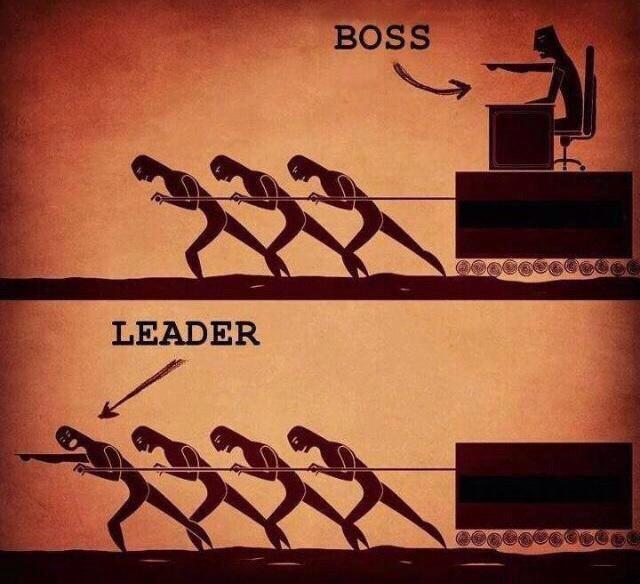
Do you approach coaching like the transactional boss whose primary (although often hidden) agenda is to build his/her own resume’ off the backs of others for the sake of job security or personal promotion?
Or do you approach coaching like the servant-leader who understands his/her Propósito, and views the opportunity to lead as an opportunity to invite the masses to follow you on a transformational journey towards fulfilling that Propósito, allowing them to discover & fulfill theirs in the process?
As our societal love-affair with sport continues to increase in scope and influence, we as a culture desperately need coaches to define their Propósito and lead the multitudes down the path of transformation. As a powerbroker of sport, will you use your power to serve… or to be served?
Influencing the Influencers
Influencing The Influencers
By Wes Simmons
We’ve been helping coaches implement the 3Dimensional Coaching philosophy for many years now, and it’s having a powerful impact. Katie Gremar, a high school soccer coach in Illinois, shares part of her transformational journey below:
Anna* was new to the soccer team. She was a standout athlete, and she knew it. She had amazing speed and found a niche as a starting defender who could help us win games. In short, she was an influencer and it appeared that her influence would be a great asset to the team.
As the soccer season began, things went well. However, after we lost a few games she started becoming negative. Her negativity was compounded by the fact that, as a defender, she wasn’t able to score any goals. Her negative tone quickly began pulling the rest of the team down to her level. Half of the girls were terrified of her while the other half just loyally followed her so as not to risk her wrath.
In one of those early season losses, she simply gave up midway through the game. I pulled her off the field and sat her on the bench. I told her, “Come and talk to me when you are ready to volver in.” She put on her warm-ups and just sat there.
One of the captains came up to me and asked, “Can Anna volver in the game?”
“Yes,” I said. “But Anna needs to come talk to me first before she goes back in.” The captain went to take the message to Anna, but Anna shut her down. She had no regard for authority or her teammates.
The drama continued. A few games later, Anna ran her mouth on the bus so I benched her for the following game. To say she didn’t respect me would be a HUGE understatement. It came to the point where Anna didn’t talk to me and I simply ignored her (as long as she worked hard). The problem was, she stopped working hard! I had to address it.
She was obviously lacking Motivación, and because I didn’t have any 2da Dimensión strategies, I tried to deal with her 2da Dimensión issues in the 1st dimension. All I knew to do was punish her lack of effort by making her do sprints. Because soccer is a team sport, I decided to make the entire team do the sprints. Needless to say, I was nobody’s friend by the end of that season. As I thought about the next year, all I could do was PRAY that she would not come out for soccer again. She was a great player, but I was at a loss about how to handle her behavior.
“How does it feel to be coached by me?”
The following summer, I read Joe Ehrmann’s InSideOut coaching book and transformation began to take place in MY heart. While the entire book was excellent, the one thing that really struck me was the part that challenged me to think about this haunting question. Quite frankly, I didn’t like the answers I came up with. I was treating 3ra Dimensión issues, almost exclusively, with 1st dimension solutions. Although I said I loved my players and that I wanted them to be more than just athletes, in reality I didn’t model it. This was especially true with the ones who were tough to love (like Anna).
The next school year got started and I was eager to begin transforming my team. Part of my plan was to attend at least one off-season event for each of my players. I wanted them to know that they mattered to me in the off-season as much as they do during the season. Anna played another sport in the off-season as well, so I went to a game to cheer her on.
I texted her after the game to congratulate her on her performance, and her response was surprisingly positive! I decided to go to another game and we talked some more. Our relationship was improving, but I was also hearing rumors that she might not play soccer in the upcoming season. But when the week of tryouts finally rolled around, for better or worse, there she was.
I was determined to keep things more positive this year. Team-wide, we focused on holding each other accountable. I partnered the girls up with people they wouldn’t normally be partners with and made them accountability partners for the entire season. They had to check in with each other every week to see if they had achieved their goals. I assigned Anna to a freshman, and Anna rose to the occasion.
We started the affirmation circles at the end of every practice (a variation of the “Spotlight Drill”). It was amazing to see my girls start looking for the positive in each other on a daily basis, and Anna was no exception. She owned her position on defense so well that there were even a few games where I gave her the option to go play forward so she could SCORE! She responded by saying, “No, I’m better for the team playing defense.” She never missed a practice, she played through injuries, and she was often the player who would be first to pick up equipment after practice. She is now leading her teammates by serving them. It’s a complete 180° turn from the year prior!
I have to believe at least some of the positive change comes from the fact that she now knows how much I care for her. I truly want to see her succeed in every area of her life. Once I realized that I needed to be more intentional about showing her that, the change was almost instantaneous. It’s carried over into the rest of the team as well. This year I’ve lost count of how many of my girls have told me how excited they are for soccer to start again. This has not been the norm in previous years.
If things continue as I suspect they will, Anna will be a senior captain for me next year. She recently asked me to contact a college coach for her about playing there in the fall, and it’s a recommendation that I will gladly write. Anna was an incredibly hard player to coach two years ago, but one that I am grateful for every day now. I like to think that her poor attitude was her way of demanding my best. Through her negativity, she demanded that I show her I cared. Once I did, she was willing to give me her best. She is now using her influence in the right direction.
3D Parenting Video
Use the video below to help parents understand their role in stewarding the growth of their athletes in all 3Dimensions.

